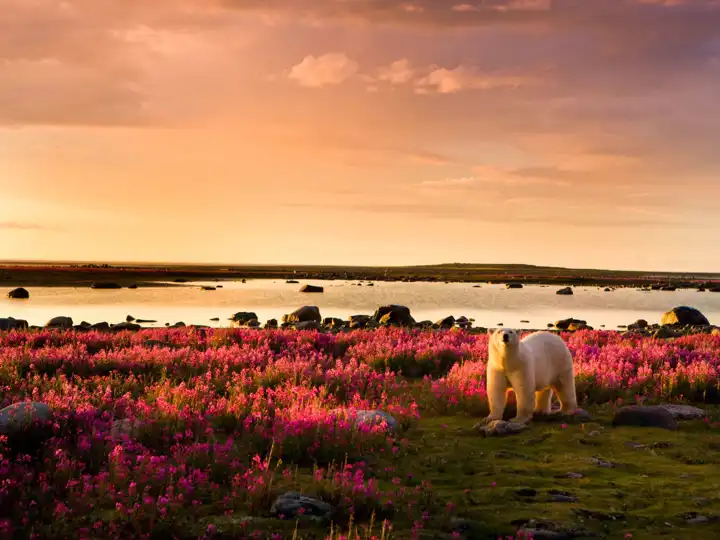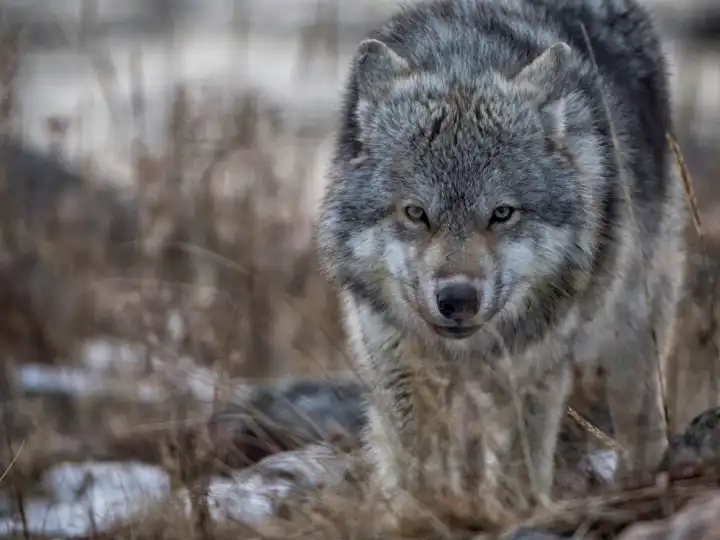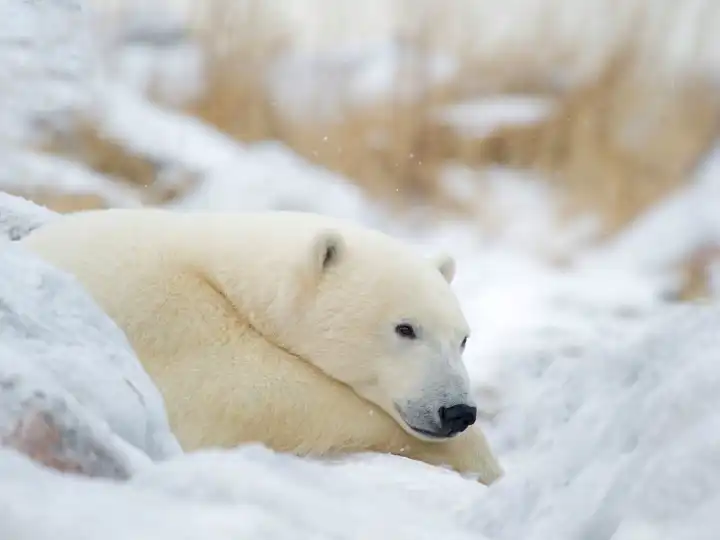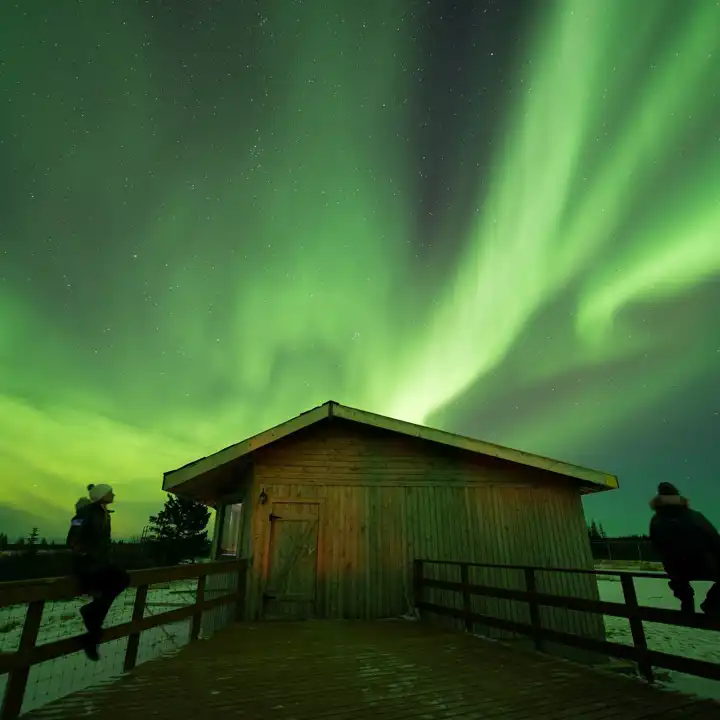Bears and Belugas, Oh My!
As Seen in QUEST Magazine
By Lauren Kramer
There is only one place in North America where you can watch hundreds of beluga whales cavort in the wild. In Churchill, a small town in northern Manitoba 1,200 miles from the province’s capital, the population of people might be diminishing, but not the number of whales.
Indeed, some 5,000 beluga whales spend their summer in western Hudson Bay. Meanwhile, up to 3,000 head to the Churchill River estuary. The two waterways meet at the lip of land bordered by Churchill. The whales therefore move in and out of the estuary with the tides as they feed on capelin and Lake Cisco fish.
At first glance from land, the belugas look like sandbars, or whitecaps on the waves. But look closely and you realize those whitecaps are actually hundreds of smooth beluga backs, surfacing briefly for air before they dive down again.
They come to calve in the Churchill river in the summer. Then by the middle of August, there are gray-brown baby belugas to be found in every pod. Their color fades first to gray-blue and then to white as they mature.

Kayaking with Beluga Whales
To get a better view on my travels to Manitoba, I clad myself in a thick wetsuit, life jacket, and neoprene boots and hop into a single, sturdy kayak in the Churchill River, allowing myself to gently paddle through the low tide. At first I see nothing but the great blue-green vastness ahead of me, the occasional jellyfish floating along the surface. Then suddenly they are below and all around me. A pod of ephemeral, ghostly beluga whales swim gracefully through the water.
Sound is everything to these mammals. To be sure, their chirping and shrill, seagull-like calls have earned them the nickname canaries of the sea. They are the world’s most vocal whales, after all.
So I start to hum and soon find myself a few feet from an eight-foot beluga, which turns its body toward my kayak. Releasing a balloon of bubbles that cascade upwards, the beluga slips playfully from its stomach to its back. Then, with a barely visible movement of its tail, it is gone.
They are spectacular to watch. These gliding, 13-foot mammals live up to 60 years and can dive to depths of nearly 2,000 feet without even feeling the cold. On a summer’s day in Churchill, even a wetsuit can’t keep the splashes of 42-degree Fahrenheit water from chilling my bones. Yet I stay the course, transfixed by the eerie beauty of these underwater habitants.
At first the belugas keep a cautious 15-foot distance from me. But after a half hour they are friendlier, their bodies trailing our kayak's wake. Some sport the claw marks of a polar bear who just missed his prey. In the Churchill River, they can cavort in relative safety from their two main predators: orca whales and Greenland sharks.
Then suddenly they are below and all around me. A pod of ephemeral, ghostly beluga whales swim gracefully through the water.

The Polar Bear Capital of the World
There are two main draws to Churchill, a town only accessible only by air, sea, or rail. One of them is the belugas. The other is its polar bears.
The belugas don’t disturb anyone, but with the bears, it’s a different story.
Churchill is a natural stopping point for the population of close to 1,000 polar bears that roam this terrain. In the summer, when the ice begins to melt, the 1,760-lb carnivores come on land 80 miles away. They then prepare to wile away the hot days until October, when ice begins to form on Hudson’s Bay once again.
From July to November, the bears hunt for belugas following a winter diet consisting primarily of seals. Instinctively, they know that the bay will soon ice over, meaning their winter sojourn in search of food can begin. So, they pace the tundra, testing the ice and resting to conserve energy. They also scavenge for edible seaweed and occasionally, spar with other bears.
It’s one thing to see polar bears in a zoo, where they’re at a safe distance and possessed by the lethargy and boredom that goes hand in hand with confinement. But to see them in the wild is a completely different experience. With no natural enemies but man, the bears embrace their role as kings of the Arctic. They are capable of picking up a scent 20 miles away and detecting their prey under three feet of snow and ice.
Of the 16,000 polar bears in Canada, an excess of 900 of them pass through Churchill and the Hudson Bay area each year. This has earned the town the nickname the ‘polar bear capital of the world.’ Though the number of actual bears is relatively small, it’s their concentration that makes this area remarkable.

Most travelers will opt for massive Tundra Buggies to transport them across the tundra on mass-market Churchill polar bear tours. However, the best and most intimate Ice Bear experience resides in a few exclusive fly-in safari lodges outside of town.
Here, you are invited to walk amid the polar bears. Accompanied by several expert naturalist guides, just a handful of adventurers-at-heart venture single-file by foot along the Hudson Bay coastline in search of not only bears, but also wolves, arctic fox, arctic hare, moose, and birdlife.
For those who question the safety of such an outing, rest assured that the lodge guides have been thoroughly trained in reading the bears’ expressions and come armed with five levels of deterrents. Though after more than three decades of leading walking safaris, they have never once had to shoot a bear. After seeing them in action, you can see why. Their immense amount of respect for these animals greatly exceeds their fear.
The first polar bear I see is fast asleep. Its curled up bundle of yellow fur acts totally oblivious to the camera shutters clicking in a wild effort to capture his peaceful slumber. Bear number two is equally disinterested in his human onlookers, but at least he’s not playing dead. He’s hauling his 1,500-lb torso on a long, slow amble across the tundra.
Living with Polar Bears
At times over the years, the bears’ path has conflicted with that of Churchill’s residents. To solve the problem, a polar bear holding facility was established in 1982 to incarcerate pesky bears that frequented the town dump or the town itself. With a capacity of 28, the facility jails the bears in solitary confinement until the bay freezes over. At that time, the bears are released onto the ice.
The facility works in conjunction with a Polar Bear Alert Program. This 24-hour service keeps track of bears around Churchill and deposits them in the holding facility when necessary. When the jail is full, they fly the offending bears north by helicopter and release them onto the ice where they’re less likely to cause havoc.

Once a bear has learned to associate the town with food, it’s difficult to break that behavior pattern. Many residents have stories of close bear encounters with potentially lethal outcomes. So, the bear jail and alert program help the town’s population rest easier at night.
Over the last four decades the holding facility has been utilized about 2,350 times. This has reduced the number of defense kills considerably. It therefore protects both the human and bear populations that call this region home.
The risk of bear encounters forces people to live more cautiously. There are signs everywhere warning that bears could be close and encouraging visitors and residents to keep their wits sharp and their eyes open. Still, there’s more chance of being killed by a bus than a bear in this town, locals say.
Bucking the Trends
During my visit, I met researchers who have studied the effects of climate change on the polar bear population. Concerns surrounding global warming on Arctic Sea ice—the polar bear's hunting grounds—have set off alarm bells for conservationists and scientists for decades. After all, less hunting time on the ice translates to more time on land. This leads to less body weight and, eventually, severe implications on their ability to give birth and wean their cubs.

And yet, the Western Hudson Bay polar bear numbers have proven resilient compared to their Arctic neighbors. According to a 2024 report by zoologist Dr. Susan Crockford for The Global Warming Policy Foundation, not only have polar bear numbers in Western Hudson Bay not declined since 2004; a recent 2021 survey of Southern Hudson Bay bear populations actually increased 30% over five years.
This population is one of the world's most celebrated. And their survival continues to buck the scientific trends, despite all previous research saying otherwise.
For travelers seeking safe, responsible, close-up encounters with polar bears in their natural habitat, there is simply no place like Churchill. The ‘polar bear capital of the world’ continues to wear its stripes proudly.
Travel to Manitoba on a Polar Bear Tour with Ker & Downey
At Ker & Downey, each itinerary is designed to reflect who you are. When you travel with us, you can expect exceptional service from start to finish. To start planning your own polar bear tour experience, contact a Ker & Downey destination specialist. For daily travel inspiration, follow us on Instagram, Facebook, or X.

Seasonality in Manitoba
The ideal Polar Bear viewing season runs from July through November.
The Polar Bear and Beluga whale seasons overlap for a short time during July and August. Black bears, wolves, and—if you're lucky—foxes, hares, and moose can also be spotted during this time.
The Northern Lights, or Aurora borealis, illuminates the Churchill sky nearly 300 nights per year. For the best chance of seeing the Northern Lights, travel between August through November or late January through April.

Quest Magazine
Dedicated to the experiential style of Ker & Downey travel, QUEST Magazine features eye-opening content that focuses on unforgettable experience, unheard-of destinations, and the very best our world has to offer. Each issue is packed with insider information, what's new in the world of travel, and editorial pieces that focus on our global culture, philanthropy, and transformative travel.
Read The Family Issue